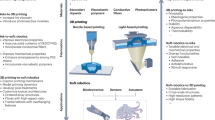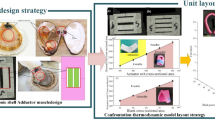Abstract
Soft robots and actuators are emerging devices providing more capabilities in the field of robotics. More flexibility and compliance attributing to soft functional materials used in the fabrication of these devices make them ideal for delivering delicate tasks in fragile environments, such as food and biomedical sectors. Yet, the intuitive nonlinearity of soft functional materials and their anisotropic actuation in compliant mechanisms constitute an existent challenge in improving their performance. Topology optimization (TO) along with four-dimensional (4D) printing is a powerful digital tool that can be used to obtain optimal internal architectures for the efficient performance of porous soft actuators. This paper employs TO analysis for achieving high bending deflection of a 3D printed polyelectrolyte actuator, which shows bending deformations in response to electrical stimuli in an electrolyte solution. The performance of the actuator is studied in terms of maximum bending and actuation rate compared with a solid, uniformly 3D printed and topology-optimized actuator. The experimental results proved the effectiveness of TO on achieving higher bending deformation and actuation rate against a uniformly 3D printed actuator.










Similar content being viewed by others
References
Cohen E, et al. Design methodologies for soft-material robots through additive manufacturing, from prototyping to locomotion. In: ASME 2015 international design engineering technical conferences and computers and information in engineering conference. American Society of Mechanical Engineers; 2015.
Koloor S, et al. FE model-based construction and progressive damage processes of FRP composite laminates with different manufacturing processes. Int J Mech Sci. 2018;141:223–35.
Zolfagharian A, et al. Polyelectrolyte soft actuators: 3D printed chitosan and cast gelatin. J 3D Print Addit Manuf. 2018;5(2):138–50.
Zolfagharian A, et al. Evolution of 3D printed soft actuators. J Sens Actuators A Phys. 2016;250:258–72.
Zolfagharian A, et al. Pattern-driven 4D printing. J Sens Actuators A Phys. 2018;274:231–43.
Bodaghi M, Liao W-H. 4D printed tunable mechanical metamaterials with shape memory operations. Smart Mater Struct. 2019;28:045019.
Bodaghi M, Damanpack A, Liao W. Self-expanding/shrinking structures by 4D printing. Smart Mater Struct. 2016;25(10):105034.
Bodaghi M, et al. 4D printing self-morphing structures. J Mater. 2019;12(8):1353.
Gao B, et al. 4D bioprinting for biomedical applications. Trends Biotechnol. 2016;34:746–56.
Zolfagharian A, et al. Rigid elements dynamics modeling of a 3D printed soft actuator. Smart Mater Struct. 2018;28(2):025003.
Zolfagharian A, et al. System identification and robust tracking of a 3D printed soft actuator. Smart Mater Struct. 2019;28:075025.
Ionov L. Biomimetic hydrogel-based actuating systems. Adv Funct Mater. 2013;23(36):4555–70.
O’Grady ML, Kuo P-L, Parker KK. Optimization of electroactive hydrogel actuators. ACS Appl Mater Interfaces. 2009;2(2):343–6.
Zolfagharian A, et al. Bending control of a 3D printed polyelectrolyte soft actuator with uncertain model. J Sens Actuators A Phys. 2019;288:134–43.
Shiga T, Kurauchi T. Deformation of polyelectrolyte gels under the influence of electric field. J Appl Polym Sci. 1990;39(11–12):2305–20.
Li Y, et al. Electric field actuation of tough electroactive hydrogels cross-linked by functional triblock copolymer micelles. ACS Appl Mater Interfaces. 2016;8(39):26326–31.
Sigmund O, Maute KJS, Optimization M. Topology optimization approaches. Struct Multidiscip Optim. 2013;48(6):1031–55.
Huang X, Xie YM. Convergent and mesh-independent solutions for the bi-directional evolutionary structural optimization method. Finite Elem Anal Des. 2007;43(14):1039–49.
van Dijk NP, et al. Level-set methods for structural topology optimization: a review. Struct Multidiscip Optim. 2013;48(3):437–72.
Bendsøe MP, Sigmund O. Material interpolation schemes in topology optimization. J Arch Appl Mech. 1999;69(9–10):635–54.
Yang R, Chen C. Stress-based topology optimization. J Struct Optim. 1996;12(2–3):98–105.
Hongying Z. Development of topology optimized 3D printed soft grippers and dielectric soft sensors. PhD diss. National University of Singapore (Singapore). 2018.
Schumacher A. Mathematische Grundlagen der Optimierung. In: Optimierung mechanischer Strukturen. Springer; 2013. p. 45–55.
Harzheim L. Der Natur in die Karten geschaut–Optimierungsverfahren aus dem Bereich der Bionik. In: Karosseriebautage Hamburg 2016. Springer; 2016. p. 3–16.
Huang X, Xie M. Evolutionary topology optimization of continuum structures: methods and applications. Hoboken: Wiley; 2010.
Zhang H, et al. Topology optimized multimaterial soft fingers for applications on grippers, rehabilitation, and artificial hands. J IEEE/ASME Trans Mechatron. 2019;24(1):120–31.
He D, Liu S. BESO method for topology optimization of structures with high efficiency of heat dissipation. Int J Simul Multidiscip Des Optim. 2008;2(1):43–8.
Kim M-G, Kim J-H, Cho S-H. Topology design optimization of heat conduction problems using adjoint sensitivity analysis method. J Comput Struct Eng Inst Korea. 2010;23(6):683–91.
Gersborg-Hansen A. Topology optimization using the finite volume method. Proceedings of 6th World Congresses of Structural and Multidisciplinary Optimization. 2005.
Kaup IA. Frequency Selective Deblocking Filter for HEVC. Master diss. 2018.
Svanberg K. The method of moving asymptotes—a new method for structural optimization. Int J Numer Methods Eng. 1987;24(2):359–73.
Wiedemann J. Leichtbau: Elemente und Konstruktion. Berlin: Springer; 2007.
Tavakoli R, Mohseni SM. Alternating active-phase algorithm for multimaterial topology optimization problems: a 115-line MATLAB implementation. Struct Multidiscip Optim. 2014;49(4):621–42.
Zhang H, et al. Topology optimized design, fabrication and evaluation of a multimaterial soft gripper. In: 2018 IEEE International Conference on Soft Robotics (RoboSoft). IEEE; 2018.
Stamm C. Hochgeschwindigkeitsvideoverarbeitung im Sport. Informatik-Spektrum. 2013;36(5):431–9.
Wüst S, et al. Tunable hydrogel composite with two-step processing in combination with innovative hardware upgrade for cell-based three-dimensional bioprinting. Acta Biomater. 2014;10(2):630–40.
Lee JM, et al. Design and printing strategies in 3D bioprinting of cell-hydrogels: a review. Adv Healthc Mater. 2016;5(22):2856–65.
Wu Q, et al. Solvent-cast 3D printing of chitosan hydrogel scaffolds for guided cell growth. 2016.
Hinton TJ, et al. Three-dimensional printing of complex biological structures by freeform reversible embedding of suspended hydrogels. Sci Adv. 2015;1(9):e1500758.
Zolfagharian A, et al. 3D printed soft parallel actuator. Smart Mater Struct. 2018;27(4):045019.
Author information
Authors and Affiliations
Corresponding author
Rights and permissions
About this article
Cite this article
Zolfagharian, A., Denk, M., Bodaghi, M. et al. Topology-Optimized 4D Printing of a Soft Actuator. Acta Mech. Solida Sin. 33, 418–430 (2020). https://doi.org/10.1007/s10338-019-00137-z
Received:
Revised:
Accepted:
Published:
Issue Date:
DOI: https://doi.org/10.1007/s10338-019-00137-z




